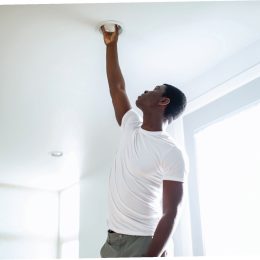
After line crews worked a long, hard day on storm-damaged power lines, Kosciusko REMC lineman Kelly Neace re-energizes the repaired stretch of line to restore service — just in time for nightfall. Electric co-ops follow a methodical pattern of restoring service after major storms — be they tornadoes, hurricanes, thunder storms or ice storms. File photo by Richard G. Biever
How co-ops power up consumers after a storm
Waves of thunder rumble a warning, then roar as rolling dark clouds gather overhead. Strong winds whip through the trees. Lights flicker, then suddenly go dark, as errant trees and limbs somewhere along the way fall into power lines.
Some storms are more silent. They come in the dead of winter as layers upon layers of ice collect on trees and spread slowly over power lines. One inch of ice gripping a single span of electric wire weighs as much as 1,250 pounds – a force capable of causing far more damage than wind as the weight drives tree branches and power lines to the ground.
Tornadoes, hurricanes, ice storms, blizzards — no matter the weather, the end result may be temporary power loss. Local electric cooperatives routinely trim back foliage and remove trees hovering dangerously close to power lines to prevent outages, a process called right-of-way maintenance. But when nature prevails, co-op lineworkers, engineers, and other employees are standing by around the clock, ready to take action to get your lights back on.
First things first: report your outage by calling your co-op. If the lines are busy, keep trying. Then it’s a matter of waiting until repairs can be made.
Ever wonder how your co-op decides where to start restoring power? When electric co-op workers begin assessing storm damage, they focus on fixing the biggest problems first, prioritizing repairs according to how quickly and safely they can get the most homes back into service.
Step One: Clearing the path
The flow of electricity is much like a river in reverse. It originates at a single ocean of power (a generation plant) and diverges from there into a series of transmission lines, substations, and smaller feeder lines until it reaches homes and businesses at a trickle of its original strength.
Transmission lines, which carry power at high voltages from power plants, and local substations, where the voltage is lowered for safe travel to neighborhoods, must both be inspected for damage and repaired before any other efforts take place. After all, if the substation linked to your neighborhood’s power supply has been damaged, it doesn’t matter if lineworkers repair every problem near your home — the lights will stay dark.
Step Two: Bulk efforts
After restoring the flow of power to local substations, co-ops focus on getting power back to the greatest number of members. Distribution lines in highly populated cities and communities are checked for damage and repaired quickly, delivering electricity to most members.
What does this mean? You might live on a farm with neighbors a mile or two away, or you could live in a neighborhood surrounded by 10 or 20 homes. Folks in neighborhoods will likely see power return before members in remote areas. Line repairs are once again prioritized by the number of members who benefit.
Step Three: One-on-one
After fixing damage blocking power from large pockets of members, your co-op focuses on repairing tap lines (also called supply or service lines). These lines deliver power to transformers outside homes and businesses. This is the final stage of power restoration, requiring a bit more patience.
Individual households may receive special attention if loss of electricity affects life-support systems or poses another immediate danger. If you or a family member depend on special medical equipment, call your co-op before an emergency arises.
Still in the dark?
If you notice your neighbors have power while you remain out of service, there might be damage between your home and the transformer on a nearby pole. If you didn’t report your outage earlier, be sure to call your co-op so a line crew can make repairs.
There are limits to what the co-op can repair. You — not the co-op — are responsible for damage to the service installation at your home or business. Call a licensed electrician to handle repairs if this is the case.
Stay safe!
After a severe storm, broken power lines may land on the ground or in roadways. Stay away from all fallen power lines and report them to your co-op. Electricity could still be flowing through the lines, making them dangerous.
While avoiding downed power lines may seem simple enough, there are other silent but deadly safety concerns after a storm. If a power outage lasts longer than two hours, consider perishable food. Throw away any food that’s been exposed to temperatures above 40 F for two hours or more. An unopened refrigerator keeps food cold for about four hours, while food in a full freezer stays safe for about 48 hours.
If using a portable generator, connect equipment you want to power directly into outlets on the generator with a properly rated extension cord. Remember — never operate a generator inside your home (risk of carbon monoxide poisoning) or connect a generator directly to your home’s wiring unless your home has been wired for generator use.
Lineworkers’ lives could be put in danger from power backfeeding onto electric lines.
Some folks want the convenience of hooking up a generator directly to their home. Connecting the generator to your home’s circuits or wiring must be done by a qualified, licensed electrician who will install a transfer switch to prevent backfeeding.
Stay prepared
While utilities work hard to reduce the impact strong winds and ice have on power lines, it’s good to be prepared for any disaster that might hit your community.
Store a few basic items in your home for any wide-scale emergency. Remember to store handy tools like a radio, can opener, flashlights, extra batteries, hand sanitizer, and first aid supplies. Include a seven-day supply of medications for you or other family members. Finally, retain copies of important documents — birth certificates, passports, and insurance policies.
Further customize your emergency kit. Think about including family photos, candy, nuts or other snack food, even a deck of cards to help pass the time. Rechargeable flashlights in key areas of the home provide instant light if the power goes out. — Megan McKoy-Noe, National Rural Electric Cooperative Association




